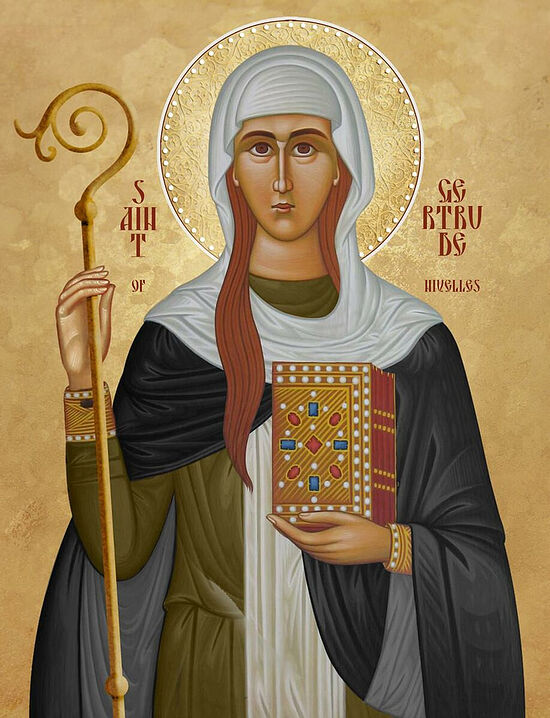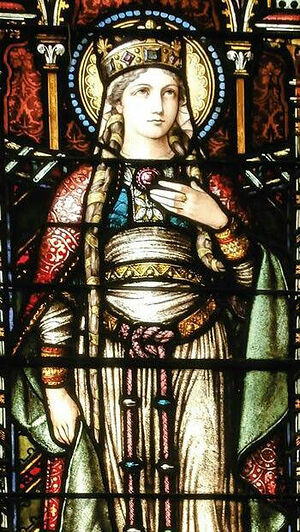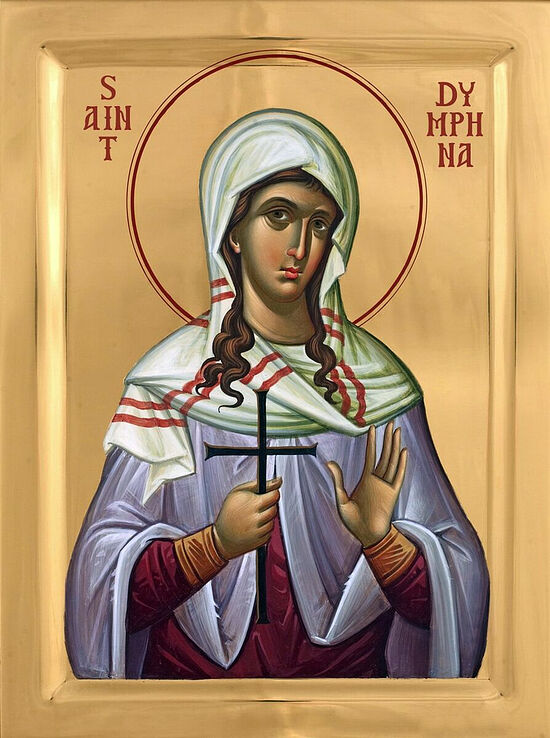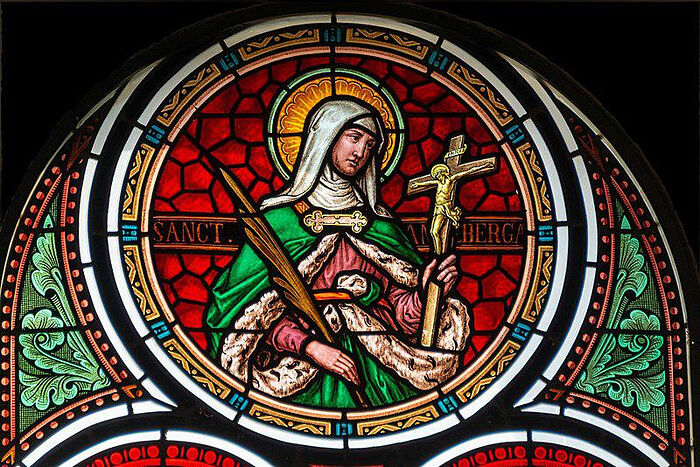Part 2: Missionaries and Enlighteners
Part 3: Great Monastic Saints and Penitents
We continue with an amazing series on the Orthodox saints of what is now call Benelux, by Matthew Hartley.
St. Ermelinde of Meldert (†594)
St. Dymphna of Geel (†c.650)
St. Itta of Nivelles (†652)
St. Gertrude of Nivelles (†659)
St. Wulfetrude of Nivelles (†669)
St. Begga of Landen (†693)
St. Amalia of Maubeuge (†c.690)
St. Reineldis of Saintes (†c.700)
St. Gudula of Brussels (c.712)
St. Pharaildis of Ghent (†740)
St. Irmina of Oeren (†720)
St. Berlindis of Meerbeke (†c.702)
St. Landrada of Munsterbilzen (†c.708)
St. Amalberga of Temse (†772)
St. Ava of Denain (†845)
St. Amelberga of Susteren (†c.900)
St. Cunigunde of Luxembourg (†c.1040)
Among the greatest adornments of the Low Countries during the period of their Orthodox history is their holy women. Indeed, this area is remarkable both for the number and brilliant holiness of the saintly women who shone forth from it. They are among the very greatest saints of pre-Schism Western Europe.
St. Ermelinde of Meldert was a hermitess. Of wealthy stock, she desired from early on to flee the world, to which end she sheared off her own hair to avoid a potential marriage. Her parents acquiesced to her wishes for a life of prayerful solitude and provided her a small plot of land. Her life seems to have been largely uneventful in terms of external drama, save for one incident in which two young men plotted to kidnap the holy maiden; warned by an angel of their machinations, she fled her native Beauvechain in Wallonia for Meldert in the Brabant region, where she lived out her days in prayer and charitable giving.
St. Dymphna of Geel continues the trend discussed earlier of saints of this region with Irish origins. She was an Irish princess, the daughter of a pagan king, Damon, and his Christian wife. St. Dymphna’s mother had her secretly baptized by St. Gerebern, a priest who would serve as her spiritual father and, later, co-sufferer.
Around the time St. Dymphna reached adolescence, her mother died. Her father, mad with grief, developed an unnatural desire for his daughter, who, it is said, was quite beautiful and strongly resembled her mother. King Damon began making impure advances to his daughter Dymphna who, understandably, was horrified. She had no choice but to flee, which she did in company with St. Gerebern and some attendants.
The ship on which St. Dymphna and her companions fled landed at length in the port city of Antwerp in present day Belgium. In the nearby town of Geel, in an oratory dedicated to St. Martin of Tours, St. Dymphna used her considerable resources to establish a hospital for the poor, where she labored personally and evinced gifts of healing.
Her father, having altogether lost his sanity, had set off with some guards after St. Dymphna. Tracking her down at last, he confronted her and St. Gerebern. When the latter rebuked him for his unseemly and evil conduct, King Damon had the elderly priest beheaded. After St. Gerebern’s martyric death, the king continued to press Dymphna to marry him. Enraged at her firm, continued refusal, he then beheaded her with his own sword. Thus, St. Dymphna followed St. Gerebern into the Heavenly Kingdom, at about the age of 15–16.
The bodies of the two martyrs were interred nearby. Over time, untold numbers of miraculous healings occurred at the site of St. Dymphna’s martyrdom. People suffering mental illness, possession, and epilepsy seemed to derive particular relief and benefit. With time, an entire complex and sanitarium for the treatment of the mentally ill developed in Geel, which became famous throughout Europe. To this day, she is a powerful heavenly intercessor for victims of incest and sexual abuse as well as for those suffering mental illness.
 St. Itta of Nivelles Around the same general time as St. Dymphna was undergoing her martyric struggles, a family of holy women was establishing what would be one of the great monastic centers of this region of Europe. This was the Abbey of Nivelles in Belgium. The mother, St. Itta, was of the highest social rank, wife of the Frankish Mayor of the Palace, but upon her husband’s death gave up the world for a monastic vocation. Her brother, St. Modoald (†c.645), served as Archbishop of Trier in Germany. Under the spiritual guidance of St. Amandus (see above), with her daughter Gertrude she established the monastery at Nivelles, which operated by the rule of the Irish missionary St. Columbanus, where she lived as a simple nun under her daughter’s direction and where she reposed in peace.
St. Itta of Nivelles Around the same general time as St. Dymphna was undergoing her martyric struggles, a family of holy women was establishing what would be one of the great monastic centers of this region of Europe. This was the Abbey of Nivelles in Belgium. The mother, St. Itta, was of the highest social rank, wife of the Frankish Mayor of the Palace, but upon her husband’s death gave up the world for a monastic vocation. Her brother, St. Modoald (†c.645), served as Archbishop of Trier in Germany. Under the spiritual guidance of St. Amandus (see above), with her daughter Gertrude she established the monastery at Nivelles, which operated by the rule of the Irish missionary St. Columbanus, where she lived as a simple nun under her daughter’s direction and where she reposed in peace.
St. Gertrude, first abbess of the monastery of Nivelles, is one of the outstanding holy figures of the region and one of its most enduringly revered and beloved saints. In her brief life of only thirty or so years, she achieved an astonishing degree of holiness that has ensured her continued veneration over the centuries.
 Icon of St. Gertrude of Nivelles
Icon of St. Gertrude of Nivelles
That St. Gertrude was of unusually firm character and strong in her convictions was evident from her early youth. One particular account vividly illustrates this: At a dinner hosted by her father when the girl was only about ten years old and at which the king himself was present, the king offered Gertrude the prospect of a politically advantageous marriage to the son of a duke. The girl adamantly rejected the offer, fearing not even to offend the king, and affirming instead even from that young age her determination to dedicate herself solely to the Heavenly Bridegroom, Christ. And, indeed, all her life she would keep unbendingly to this early, categorical determination of hers.
 Fresco icon depicting Sts. Itta and Gertrude of Nivelles
Fresco icon depicting Sts. Itta and Gertrude of Nivelles
St. Gertrude took monastic tonsure from her mother, St. Itta. They apparently had reason to fear the girl’s abduction from various parties who might have sought to marry her by force. The Abbey of Nivelles was thus a safe haven from the world and its tumults of political strife and arranged marriages. St. Amandus seems to have been the one who recommended that it be built, at least in large part as a holy sanctuary for the pious women. Nevertheless, perhaps predictably they did encounter some royal opposition to their monastic endeavors. However, they were not to be deterred.
 The Collegiate Church of St. Gertrude in Nivelles
The Collegiate Church of St. Gertrude in Nivelles
St. Gertrude may well have served as the first abbess of Nivelles. Originally a women’s community, it soon became a double monastery. She ruled the abbey with a rare degree of wisdom, temperance, and holiness well beyond her tender years. She was characterized by great and extensive learning and generous hospitality, especially to traveling monks. Indeed, Nivelles became a beacon to holy people from all over. Among them were the holy brothers Sts. Foillan and Ultan, discussed above. Miracles came to be associated with the holy abbess: She had a vision of heavenly light while praying, and her intercessions saved a group of sailors endangered at sea. Exhausted by her vigils and severe fasts, she sensed her imminent repose. St. Ultan prophesied to her that she would repose on the feast day of St. Patrick, which indeed came to pass. A wonderful, heavenly aroma emanated from her relics immediately upon her blessed repose. Perhaps owing to her effective intercessions against rat infestations during times of plague, St. Gertrude came to be popularly associated with cats, and depictions of her frequently show her holding a cat; she has therefore come to be regarded as a patron by cat-lovers. Her feast is March 17.
Prior to her repose, St. Gertrude appointed her niece, St. Wulfetrude, to be her successor as abbess of Nivelles. She held this post capably and with great holiness of life for about ten years before her own repose in the year 669.
Another member of this pious and eminently distinguished family who should be mentioned here is St. Begga, sister of St. Gertrude. She had married the son of the holy bishop St. Arnulf of Metz (†c.645); through her son, Pepin of Heristal, she was the grandmother of Charles Martel. Upon her husband’s death she accepted monastic tonsure. Though apparently not associated with the famous Abbey of Nivelles, she was an important foundress of churches, establishing seven in the Wallonian city of Andenne on the Meuse River.
Another outstanding female monastic figure of this time period, likewise from an outstandingly holy family, is St. Amalia of Maubeuge. Her father, Geremarus (†658), is numbered among the saints, as is her son Emebert (†710) and four daughters: Ermelindis, Reineldis, Gudula, and Pharaildis. Of noble rank, the wife of a count, she and her husband by mutual consent withdrew to monasteries after the birth of St. Gudula, their youngest child. St. Amalia lived out her days in Maubeuge Abbey, located in what is now northern France near the Belgian border.
St. Reineldis, daughter of St. Amalia, is remembered as a virgin-martyr, known for her outstanding charity work in the city of Saintes in the Brabant region. She was martyred by invading Huns there in about the year 700. St. Gudula, patron saint of Brussels, was another of St. Amalia’s daughters. Her godmother, under whom she received her education and spiritual formation, was St. Gertrude of Nivelles. St. Gudula later returned to her native Moorsel in the East Flanders region. A popular anecdote from her life tells of how, early one morning on her way to church, before the sun had risen, a demon wishing to hinder her extinguished the candle she was carrying; however, through her prayers, a lantern she was carrying miraculously lit itself. There is a variety of flower known as St. Gudula’s lantern in her honor. St. Pharaildis is known as the patron saint of Ghent. She, too, was raised and spiritually formed by St. Gertrude. Though she wished for a life of consecrated virginity, she was forced into marriage with a nobleman who abused her, but she preserved her virginity to the end of her days, outliving her husband and reposing at about the age of 90. A healing well was associated with her, and she is said to have once restored a cooked goose to life. Because of her difficult marital situation, domestic abuse victims see her as a patroness and intercessor.
From Oeren (Alveringem) in the Belgian province of West Flanders came another great monastic foundress and abbess, the holy St. Irmina. While her precise family background is unclear, it is certain that she was of prominent Merovingian stock. If, indeed, as is thought by some, she was sister to St. Modesta of Trier (†c.680), then that would also make her a niece of St. Itta and a cousin to St. Gertrude of Nivelles.
St. Irmina had been engaged in her youth, but her prospective husband, Count Hermann, was murdered by a jealous servant who desired Irmina. She subsequently married another count and bore a number of children who would be influential figures in the political and ecclesiastical life of the region. Upon her husband’s death she entered monastic life, becoming abbess of a convent in Trier. She was especially noted for her hospitality to missionaries and traveling monks, who she supported with her considerable wealth. Indeed, she placed everything she had at the service of the Church, despising the wealth and luxury of her upbringing. Of particular note here was her role as co-founder, with St. Willibrord, of the monastery at Echternach in Luxembourg; it was St. Irmina who provided St. Willibrord the land for that great monastic establishment. This was done in about the year 698. St. Irmina reposed in peace in 730; her feast day is December 24.
Another female monastic saint of noble descent (and a relative of St. Amandus, no less) was St. Berlindis (Berlinda) of Meerbeke in the East Flanders region of present-day Belgium. She spent much of her life as a hermit. She was particularly known as a helper of the sick.
Another important monastic foundress of the area is St. Landrada, co-founder with St. Lambert of Maastricht (see below) of Munsterbilzen Abbey in northeastern Belgium. Of noble birth, from childhood she disdained any thought of marriage, being dedicated totally in her heart to Christ. She eventually left home for the forests of Munsterbilzen, and it was here she that lived as a hermitess in a simple hut in extreme asceticism. With her spiritual father St. Lambert she established a chapel dedicated to the Blessed Virgin at the sight where she had a miraculous vision of the Cross descending from Heaven. Thus became the foundation of the Abbey that grew up there, and which she served as its first abbess.
Variants of the name Amalberga (such as Amalia) seem to have been widespread in the Low Countries centuries ago, at least. It occurs a few times among the female saints of this region. One was St. Amalberga of Temse, greatly revered throughout Flanders and a disciple of St. Willibrord of Utrecht, discussed above. She is said to have once crossed the Scheldt River on a large sturgeon. It is also reported that the emperor Charlemagne had designs on marrying her and even attempted to take her off by force. He was unable to move her owing to a mysterious power that rendered her immovable. Stricken with illness in retribution for his sin, he repented and was healed through her prayers.
St. Ava of Denain was another female monastic saint of these lands who was of very high noble birth. She was either born blind or sometime later became so; either way, she was totally blind until a certain St. Rainfredis, another great holy woman of the area, miraculously healed her. St. Ava served as abbess of a convent in Hainaut in the Wallonia region of Belgium. She is considered a heavenly patroness of the blind, owing to her own experience of that particular cross in her life.
Yet another sainted monastic bearing a variant of the name Amalberga was St. Amelberga of Susteren. She, too, was an abbess, presiding over a convent in Susteren, in the Limburg province of the Netherlands. Susteren Abbey was apparently originally a male monastery and served as a base and refuge for St. Willibrord’s missionary activities. But after its destruction by Vikings in the late ninth century it was refounded as a convent; St. Amelberga was its first abbess. Her relics are kept there in the abbey church. She reposed around the year 900.
 Queen St. Cunigunde of Luxembourg The final great female saint we will discuss in this section is St. Cunigunde, patron saint of Luxembourg, Holy Roman Empress as wife of Henry II, and foundress of Kaufungen Abbey where she passed her last years in pious humility as a simple nun. Her life, spanning the end of the tenth to almost the middle of the eleventh centuries, brings us up to almost the eve of the Schism of the West.
Queen St. Cunigunde of Luxembourg The final great female saint we will discuss in this section is St. Cunigunde, patron saint of Luxembourg, Holy Roman Empress as wife of Henry II, and foundress of Kaufungen Abbey where she passed her last years in pious humility as a simple nun. Her life, spanning the end of the tenth to almost the middle of the eleventh centuries, brings us up to almost the eve of the Schism of the West.
St. Cunigunde had aspired from her early years to a monastic vocation, but in 999 was married to Henry. As the marriage remained childless, it is believed that Cunigunde and Henry had mutually consented before their marriage to remain celibate and never consummate the marriage. In 1002 she was crowned by St. Willigis (†1011), becoming thereby the first crowned Queen of Germany. In Rome she and her husband were crowned as heads of the Holy Roman Empire in 1014. St. Cunigunde was involved in her husband’s governance and used her influence to generously endow churches. She also founded monasteries and contributed in general to spreading piety.
 The pious and right-believing queen, St. Cunigunde of Luxembourg A number of miracles were associated with St. Cunigunde even during her earthly life. For instance, when once falsely accused of some misconduct, she proved her innocence by walking over heated irons totally unharmed. On another occasion, she caused a raging fire to be completely extinguishing by making the sign of the Cross over it. Thus, her holiness was made abundantly manifest from early on.
The pious and right-believing queen, St. Cunigunde of Luxembourg A number of miracles were associated with St. Cunigunde even during her earthly life. For instance, when once falsely accused of some misconduct, she proved her innocence by walking over heated irons totally unharmed. On another occasion, she caused a raging fire to be completely extinguishing by making the sign of the Cross over it. Thus, her holiness was made abundantly manifest from early on.
So great was the charitable giving of St. Cunigunde and her husband that, although they ruled an empire, on Henry’s repose St. Cunigunde was left in relative poverty. She retired to Kaufungen Abbey and took up the habit of a simple nun. There she lived out her days in prayer and care for the needy, until her repose sometime between the years 1033–1040. Her veneration has always been strong; it reminds great and widespread.
Few regions anywhere can boast as many awe-inspiring female saints as the Low Countries can. Chronologically, they span virtually the whole history of the ore-Schism, Orthodox West, and their lives, so varied in background and details, illustrate vividly how the Gospel of Christ can be lived in all times and circumstances.
To be continued…







